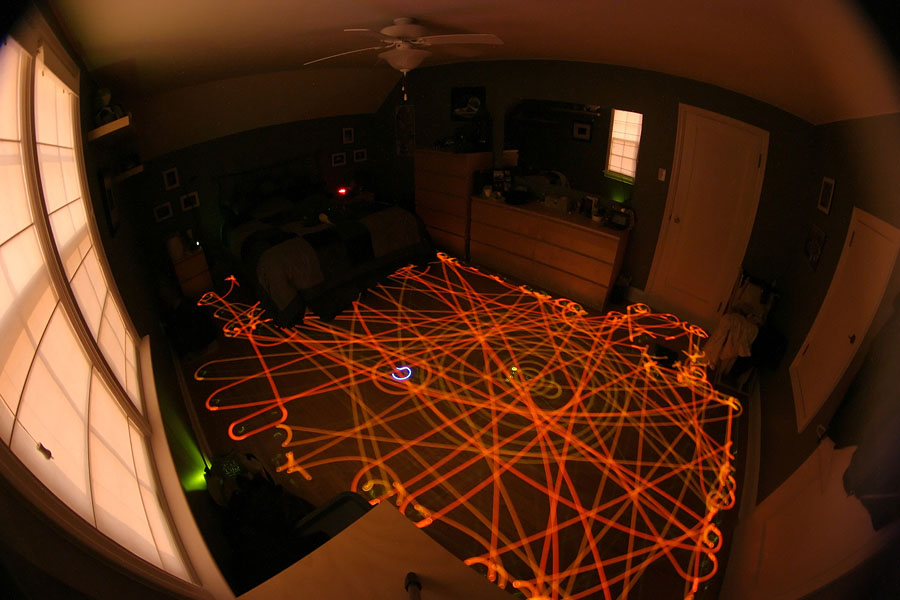

In case you were wondering about practical examples of last week's photo of hot pixels, here is a photo that I have been wanting to take for a while. This is a long exposure photograph of our bedroom being vacuumed by our Roomba, which we affectionately call "The Robot".
Our Roomba is over four years old now. It's holding up OK, aside from losing the bolt that holds the side brush on. Due to iRobot using an extremely unusual bolt size, I haven't been able to find a replacement bolt, so we've just been running it without the side brush. It's also on its second battery, and I'm starting to think that it might need a third battery soon.
Knowing what I know now, would I buy a Roomba again? Maybe. It is quite convenient to have it go off each week and vacuum the floors... but it doesn't get into the corners, and the amount of effort required to keep it clean and functioning sometimes seems like more effort than pulling out the regular vacuum. The battery lifetime seems to be an issue too, and replacements are expensive and not exactly friendly to the environment.
Anyway, I was inspired to take this photo by other Roomba owners who have done similar things. I waited until it was pitch dark outside, turned off all the lights on the second floor, guessed at some camera settings, then opened the shutter, started the robot, and went downstairs to wash the dishes. I used the dishes to determine my shutter speed, so after 20 minutes the dishes were done and I went upstairs and stopped the exposure. I think it turned out pretty well considering it was my first attempt.
By the way: Last week's photo was a 5 minute exposure... this one was 20 minutes, and the amount of noise and number of hotpixels was even more than I feared. Thank goodness for Noise Ninja and the clone tool in Photoshop. If it weren't for them, this photo would have been almost unusable. Oh well... just like my venerable robot, I'm loyal to my camera and will try to keep it operational as long as possible.
Technical details: This photo was taken with my Rebel XT + Peleng 8mm fisheye at 8mm, ISO 100, f/8 for 1213 seconds (20 minutes and 13 seconds), with +1 digital exposure compensation to bring out more detail in the room.
The light on the robot was green while it was on the charger, but as soon as I took it off, it turned yellow. This leads me to believe that the battery might not be holding a full charge anymore. The yellow spiral is how the robot always starts cleaning... spiralling outwards before it starts its random walk of the room. Soon after, the light faded from yellow to red, indicating low batteries. It cleaned the rest of the room with low batteries, it seems. That makes me kind of sad. Oh, and that little blue circle is the "dirt detect" light. Apparently it found some extra dirt on the floor and did a little circle to clean it up.-- Michael at 9:29pm, Friday March 12, 2010 EST
Very cool!-- Aravind at 12:58am, Saturday March 13, 2010 EST
Definitely considering using Camera Raw or Lightroom for the conversions, both do a great job of eliminating hot/stuck pixels. I didn't realize just how much until I loaded up long exposure images in DPP, tons of hot pixels all over the place, none show up in ACR. But if you need extra motivation to get a new camera, apart from all the shiny new gizmos the new cameras have (like higher resolution LCDs, live view, movie mode, larger EV range, better AF, etc...) steady progress has been made in noise elimination. With the XTi, amp. glow was eliminated. With the XSi, dark current noise was brought under control and finally with the T2i, read noise has plummeted. Just sayin' :)-- Aravind at 10:59am, Sunday March 14, 2010 EST
Awesome! Great photo! Fantastic idea, Mike!-- Chad at 1:29pm, Friday March 26, 2010 EST
Hosted by theorem.ca